万字长文,从四个角度谈midcore类偏社交型游戏的设定
作者:Michail Katkoff
第一环节:核心循环
老实说,我不想写关于“中等硬核”的文章。我不是喜欢学术思考的人,我所定义的“中等硬核”其实就是:针对成年男性设计的个休闲游戏,这类玩家有丰富的游戏经验,只是 现在年纪大了没时间玩了;中等硬核游戏的受众是具有稳定收入、有信用卡、有在虚拟世界竞争的渴望的成年男性。
但我能怎么办?你要求我写关于“中等硬核”的文章,我只能写了。我不打算写成一个大长篇,而是把文章分成四篇,分别以核心循环、留存率、社交性和赢利策略为主题。
作为系列的第一篇文章,我要介绍的是核心循环,包括循环结构和循环目标。我还要说说大部分中等硬核游戏的常见误区以及如何用合适的核心循环设计来避免它们。最后,我将 谈谈所有中等硬核游戏的不明显但必须的部分——元游戏。
核心循环
当我们观察成功的中等硬核游戏的核心循环时,我们会发现,它们都有三个显著的关键元素。第一个是双重循环,即每个核心循环包含两个分开的回合循环。第二个元素是中间回 合的受控长度,所谓的中间回合其实是双重循环的结果。第三个元素是元游戏,它在核心循环中是看不见的,但仍然是所有中等硬核游戏的关键部分。
1、双重循环
核心循环嵌套两个循环使玩家既可以在第一个循环后停止回合或继续玩这两个循环,这就拓展和深化了回合。这种简短的回合鼓励玩家边走边玩,增加整体沉浸感和为元游戏做好 准备,这部分后文再谈。
案例1:《Clash of Clans》

Clash of Clans(from gamasutra)
在看似简单的结构中,《Clash of Clans》的核心循环包含了三种不同的活动:资源收集、建筑和训练、战斗。这个循环的所有部分,除了建造,都鼓励玩家每天多次上线。非常 快速的30秒的回合可能只够收集资源,而战斗和培养新军队的完整回合所需的时间也不超过5分钟上。
在《Clash of Clans》中,资源收集是玩家随时可以做的事,因为自动收割机制——资源生产建筑总是处于收集状态。换句话说,任何时候玩家打开游戏,就会开始收集资源(即 使玩家已经被抢劫了)。因此,快速访问游戏鼓励玩家积极通过核心循环,而长时间离线则是轻微的惩罚,因为会损失未收集的资源。
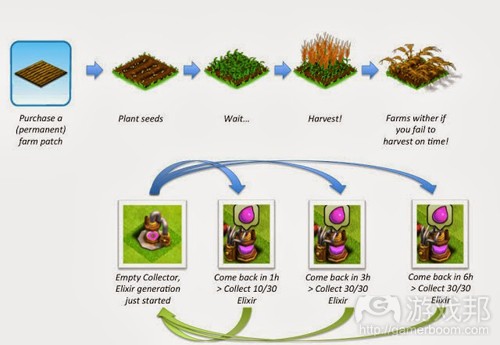
farming(from gamasutra)
(自动耕作机制鼓励玩家每天多次上线)
资源收集和被打劫的威胁是驱使低级玩家经常短时间上线的主要动力,而高级玩家则因为社交功能而返回游戏——这放在元游戏部分再说。
一开始,建造新建筑是非常快的,但随着游戏进展,速度会大大下降,成为玩家的中长期目标。为了使计时器保持平衡,军队训练更快得多,玩家一次战斗后军队再次补满通常少 于1小时。
案例2:《Marvel War of Heroes》
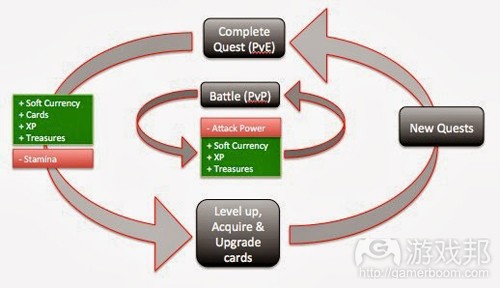
Marvel War of Heroes(from gamasutra)
这是一款卡牌战斗游戏,也是我最喜欢的一款。《Marvel War of Heroes》是成功使用双重循环的又一个经典案例。与《Clash of Clans》将核心循环与PVP紧密结合起来的做法不 同,《Marvel War of Heroes》的核心循环被分成单人循环和多人循环。
单人循环主要是刷任务和挣卡牌。玩家可以在一分钟内完成一个关卡,并获得若干卡牌。PVP循环也是一样,但时间更短,因为只有一场战斗。这两个循环受到精力机制的限制,鼓 励玩家每天多次上线。
更长的回合是由若干更短的回合组成的。当每一个回合奖励玩家若干卡牌时,玩家可能会花大量时间翻看那些获得的卡牌,这就进入升级和进化的元游戏阶段。
2、回合长度
太长的回合对中等硬核游戏来说是大忌。作为开发者,我们往往对这些游戏失去自制力,因为它们正是我们爱玩的类型。不要误解我了,长回合没有什么不好的。事实上,长回合 是玩家喜欢这款游戏的明显信号。但如果每一个回合都需要玩家保持注意力几分钟,往往会导致留存率问题。如果玩家在一天的破碎时间里不能玩上几次,玩这款游戏就不会变成 他们的习惯。当你的游戏从兴趣变成习惯,你就会看到不可思议的留存率数字。

Heroes of orders & Chaos(from gamasutra)
(Gameloft的《Heroes of Orders & Chaos》是一款很漂亮的游戏,但因为每一个回合都是10分钟的连续玩法,不能被中断,所以它不可能成为玩家打发破碎时间的习惯。)
3、元游戏(游戏中的游戏)
在我看来,所有中等硬核游戏最与众不同的元素就是元游戏。元游戏是你必须通过的核心循环中不明显的部分。在这个部分,玩家其实并不获得或消耗任何资源,而只是带着优化 自己的进程这个简单的目标,沉浸于游戏。

VEGA_Conflict_on_Facebook(from gamasutra)
(Kixeye的游戏具有最优秀的元游戏循环之一。游戏允许和鼓励玩家微管理自己的游戏,且这整个微管理元游戏其实是非常有趣的。它使玩家产生一种掌控感,这对于竞技型游戏 是非常重要的。)
短暂的中间回合最能保持玩家的沉浸感。但为了创造深刻的玩法,游戏必须也能够把玩家留在较长的回合中,也就是玩家可以深度挖掘游戏的策略,把大目标分成次要目标和主要 目标,与其他玩家互动。
关键还是平衡
毫不意外,在优秀的中等硬核游戏中,其核心循环应该走免费游戏的核心循环的相同路线。短暂、简单和有益的回合应该是主要目标。游戏不应该强迫玩家玩长回合,而是通过元 游戏引诱玩家花更多时间在游戏中。隐藏复杂度,激起玩家的好奇心,可以使游戏显得更容易上手,这是成功的元游戏的关键。当然,适当惩罚玩家不上线是可以的。
最后,不要分割你的受众。到底什么人在玩我们喜欢形容之为“中等硬核”的游戏呢?答案会让你大吃一惊的。
第二环节:留存率
留存率是免费游戏成功的基础。每天每月坚持上线的玩家使游戏作为服务的模式成为可能。但制作那种吸引玩家不断回归的游戏,绝对是游戏开发团队面临的最严峻的挑战。在本 文中,我打算详细地分析如何用紧密的核心循环、平衡的游戏经济和巧妙的使用事件来克服这个挑战。
注:当增加留存率和进度时,社交机制是必须的,但我不打算在这篇文章中介绍它,而是留给下一篇文章。
主要目标
在我看来,没有什么比“让玩家自己给自己设目标”更能让玩家留下来的了。为了达到目标,自我激励的玩家会每天上线,而且每天上线多次。但为了培养这类内在动机强的玩家 基础,游戏开发团队必须首先通过奖励玩家的进展和惩罚玩家的满后,使玩家想变得更好。
进步的渴望来自进展的渴望。渴望进展是极其强大的,因为玩家会自己为自己创造过程目标,并且努力优化自己的操作。我的观点是,渴望变得更好应该总是成为所有玩家的主要 目标。因为在设计良好的免费游戏中,进步等同于进度,而进度应该与玩游戏所花的时间成正比。
我个人喜欢把进度动机分成积极的和消极的两类。积极的动机让玩家觉得自己一旦达到目标就会变得更强更好;消极的动机让玩家觉得自己一旦停止朝着主要目标前进就会有落后 于人的危险。
进展的积极动机
内置游戏商店是鼓励进展的最好办法。获得特殊单位的价钱和解锁要求成为玩家的明确目标。另外,内置游戏商店的特殊单位的位置也是很重要的,因为它传达价值——最后一个 解锁的总是最强的、最令人渴望的。

clash store(from gamasutra)
(在《Clash of Clans》中解锁新单位是玩家的明确目标。新单位能提高战斗表现,这就给进展创造了积极动机。)
进展的消极动机
玩家的进展速度随着时间而下降。计时器会增加,价格会上涨,使进度更加难以获得。到某个时刻,下一个新单位或建筑可能看似太遥远。这时候,消极动机就产生了,让玩家不 能忍受进度滞后。

defeat(from gamasutra)
(抢劫是一个消极动机。玩家意识到当前防御不足,他们必须进展才能保护自己。这时候的消极动机最盛。)
最重要的是,当设计进展动机时,设计师应该总是记住,社交元素是一股重要的进展驱动力。进度很难客观地测量,这就是为什么游戏设计应该鼓励玩家把自己的进度与其他玩家 作比较,无论是通过合作还是竞争。我将在本系列的第三篇文章中介绍社交元素。
过程目标
过程目标是玩家认为他们达到主要目标必须经历的所有步骤。我个人喜欢给可独立的游戏经济设置过程目标。与其他策略游戏一样,《Clash of Clans》是一个使用这种经济结构 的好例子,它给玩家提供了明确的目标,且隐藏了达到那个目标必经的漫长路径。这样,玩家就会觉得通向那个最终目标的路径很短、是可以达到的。只有当他们走完一半路径, 才开始意识到,那个目标其实还很远,但在那个时候,他们已经投入太多了,根本不舍得半途而废。
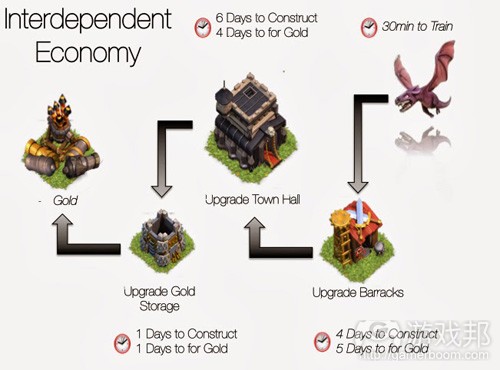
CC_Kiev(from gamasutra)
(解锁下一个单位看似相当简单的任务——玩家只需要更新兵营。但在那之前,他们必须更新市政厅。而更新市政厅太贵了,因为还要先更新金库。很直接,对吧?用最理想的玩 法,只需要21天就能达到目标。如果遇到抢劫,那21天就要翻倍了……)
过程目标可以分为两类:有些设计师喜欢向玩家透露过程目标,这就近乎强迫玩家遵循一条固定的进程路线;也有些设计师倾向于让玩家自由选择进展方式,即使这通常导致不太 理想的进度。另外,自由进展使追踪一般玩家的进度变得更加复杂,进而导致内容更新的困难。
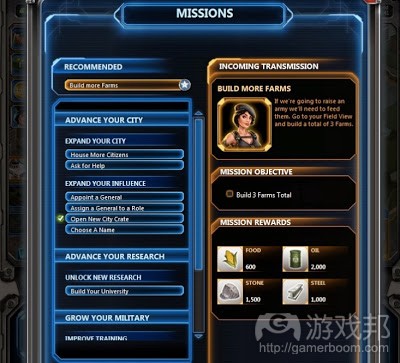
global-warfare-mission(from gamasutra)
(在Kabam的游戏中,为了完成主要目标,玩家必须遵循严格的任务结构。这有助于控制玩家的游戏流程,从而优化它。)
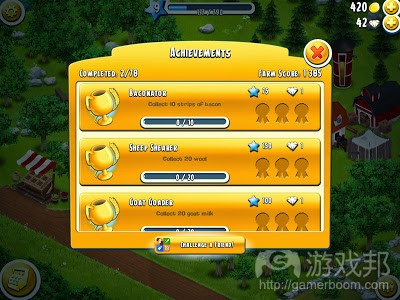
Achievements(from gamasutra)
(Supercell的游戏使用成就系统,刺激玩家重复核心循环中的活动。这个系统无助于优化玩家流程,但确实允许玩家自由地组织自己的过程目标,而不是游戏让他们做什么就做什 么。)
事件
游戏内的事件是促进短期沉浸感和提高长期留存率的强大工具。因为其限时属性,事件可以刺激玩家在比较短的时间内对游戏产生很强的沉浸感。
一般来说,事件持续的时间从几个小时到几天不等,但有时候会长达数周。事件通常是为已经玩该游戏有一段时间的玩家设计的。总体说来,事件给那些老玩家的游戏过程增加了 趣味,进而提高长期留存率。
成功的事件往往具有以下几个关键元素。第一个自然是限时性。第二个是事件专属的不可购买的奖励——如果玩家在给定的时间内完成事件,就能获得这种奖励。为了增加沉浸感 ,奖励必须是独一无二的,同时不可购买意味着这种奖励也是一种地位象征。另外,当事件结束再给予完成事件的玩家以奖励,可以提高留存率。有些玩家在事件正在进行时就感 到厌烦了,因为耗时太久。但是,考虑到事件结束就能获得实用的奖励,这些玩家就会继续玩下去,因为他们将获得新东西。最后,事件必须紧接着游戏的核心循环,而不是给核 心循环增加新元素。
案例:《Marvel War of Heroes》
在做PVE任务的过程中,玩家会不断获得宝物(可收集道具)。玩家必须收集6个才能完成一个收藏。一旦玩家拥有所有这6个道具,收藏就完成了,同时他就会得到一张独特的卡牌 。完成收藏转变为收藏奖励,同时玩家停止通过抢劫获得可收集道具。

Deconstructor_of_Fun(from gamasutra)
(玩家可以从其他玩家手中抢走自己缺少的宝物,同时,玩家可以购买限时盾牌以防止别人抢走自己的宝物。)
当然,在Ngomoco的卡牌游戏中,拥有一张珍稀卡牌是不够的,因为你必须至少有两张相同的卡牌才能组合成一张超级卡牌。这就鼓励玩家完成收藏三次:第一个收藏奖励是卡牌XY ,第二个奖励是增益效果,第三个奖励又是卡牌XY。
Ngomoco的卡牌游戏为什么能使收集变得这么有趣?这是因为你可以从其他玩家处窃取特殊宝物——当然,其他玩家也会窃取你的。当收藏完成,窃取活动也结束。
抢劫这种赢利策略非常有意思:
1、当玩家开始收集时,必须快,因为这时候别人也在盘算着你的宝物。快意味着尽量购买PVP精力,因为没有时间等精力补满。
2、为了抢到宝物,玩家必须有强大的攻击牌组。当你被打败太多次时,购买额外的牌组似乎是一笔划算的投入。
3、为了保护你自己的宝物,同时寻找自己缺少的宝物,玩家必须有强大的防御牌组。当你的防御一次又一次被攻破,购买牌组似乎是个好主意。
4、玩家还可以在自己抢来的收集道具上放一个限时盾牌。当一名玩家试图抢走被加了盾牌的道具时,他会自动失败。当玩家抢劫失败时,会看到定制动画,让他觉得很难堪。有些 玩家会把自己的所有宝物都加上盾牌,让所有那些想抢宝物的人都后悔。
每一次上线都是重要的
留存率是游戏最重要的指标。成功的中等硬核游戏能够吸引玩家玩上好几个月,每天多次上线,每次玩上个把小时。
为了达到这样的留存率指标,开发者必须确保玩家想继续进展下去,然后用可靠的游戏经济创造完成目标的路径。我不会花太多时间在所谓的“留存率特征”如每日奖励和推送通 知,因为它们的意义并不大。相反地,我更加关注游戏经济和平衡性,保证玩家想进展下去,并为此树立目标。然后,无论是引导玩家对过任务结构达成这些目标,还是让他们自 己创造自己的过程目标,务必保证每一次上线都让他们至少更加接近自己所树立的目标一点点。
第三环节:社交属性
当Facebook成为休闲游戏领域的霸主时,我才开始入行游戏业。在很长一段时间里,我把社交机制简单地当作虚拟机制——游戏开发者刺激老玩家回到游戏和吸引新玩家进入游戏 的工具。但(幸运的是)我的观点和这个统治平台都变了。
迫使玩家连接Facebook和让他们发送邀请和请求给好友,对一些开发者来说仍然是管用的策略,但你会惊讶地发现,这些机制在中等硬核游戏中的效果有多么糟。所以我不打算讨 论K因素和病毒传播力,而是专注于真正的社交机制。这种社交机制与玩法相结合,优化了整体的玩家体验,给游戏增添了活力。
合作
游戏如何“社交”起来?那就是允许玩家们一起玩游戏——或至少让玩家产生与别人一起玩的错觉。在我看来,社交机制存在的首要目标应该是提高留存率。正如我在之前的文章 中所说的,留存率主要与进度有关。但进度是相对的,不同的玩家对进度有不同的衡量标准。例如,玩游戏几周以后我可能觉得自己的进展得不错,但对于玩了几个月的玩定来说 ,我仍然是菜鸟。
为了解决进度可测量性的问题,我们可以使用社交机制。当玩家与游戏中的其他人合作时,他们就一定会互相比较进度。比较进度导致玩家产生两种感觉:一是,显然落后于人的 玩家会想奋起直追,赶上进度在他之前的玩家;二是,进度超前的玩家会自我感觉良好,并且不想失去这种先于别人的感觉。
当设计合作机制时,你必须记住一点,玩家之间的合作应该允许玩家轻易地炫耀自己。另外还要记住,合作必须对于玩家双方都有利。
《Puzzle & Dragons》
每一次玩家进入地下城,他们都必须选择另一名玩家来协助他。当玩家扫荡完地下城,他们就可以互加好友了。请朋友协助可以增加你的“好友点数”,你可以用这些点来换怪物 。

social(from gamasutra)
(《Puzzle & Dragons》的“帮手功能”遵守社交机制的黄金法则:双方都会从合作中得到好处,并且给玩家炫耀的机会。)
在进入地下城以前,玩家总是要选择一名帮手,也就是其他玩家的怪物。每一次玩家使用其他玩家的怪物作帮手,帮手的主人就会得到好友点数——可用于获得新怪物的一种游戏 币。玩家上线越频繁,他的怪物就越有机会被其他玩家选为帮手,这样他就能挣到更多好友点数。
玩家扫荡完地下城后,他可以通过发送好友请求添加帮手的主人为自己的好友。根据等级,玩家的好友数量有上限。等级越高,可添加的好友数量上限越高。使用好友的怪物作为 帮后可以产生好友点数,以及额外的领导技能—-这可以让你的怪物更强大。所以,结交活跃的好友是很重要的,因为玩家只能使用帮手一次,一次过后必须等待帮手的主人下次上 线才能再求助。
总之,《Puzzle & Dragons》中的社交机制通过鼓励每天多次上线来提高留存率。社交机制也促进玩家进展,因为玩家的怪物越好,被其他玩家选为帮手的可能性就越大,这就给 玩家带来更多好友点数,然后玩家又可以拿这些点数换到新怪物。
但最重要的是,这个功能是发生在游戏中玩家可以炫耀的地方。我的意思是,如果你的怪物很强大,其他玩家选择你的怪物当帮手,这就是一种炫耀。另外,双方玩家都从这个社 交机制中获得好处。借出怪物的玩家得到好友点数,使用别人的怪物的玩家得到帮助,完成关卡。
《Clash of Clans》
现在,我们都知道《Clash of Clans》中的军队捐赠机制很有效。当玩家加入一个部落时,他可以请求和捐赠军队。捐赠的军队可以帮助防御玩家的村庄,也可以用于进攻。这个 功能除了简单,也是我见过的最强大的社交机制之一。

Clash donate(from gamasutra)
(《Clash of Clans》的捐赠功能是我见过的最强大的社交机制之一。)
游戏没有规定玩家每周可以捐赠的军队数量是多少。当然,捐赠得越多并没有额外的好处,而捐赠得少也不会被惩罚。捐赠促进玩家之间的合作和交流,使玩家得以制定自己的规 则——能够将玩家踢出部落,这些规则也是强制的。
所以事实上,如果玩家加入活跃的部落,他就必须不断地捐赠。活跃的部落往往规定每个成员每周必须捐赠多少,如果玩家达不到规定的量且说不出充分的理由,那么就会被踢出 部落。捐赠拉动留存率,因为玩家不仅必须不断地训练军队用于捐赠,还要赶进度,因为部落当然要求玩家捐赠的军队是最好的。

Clash Donation(from gamasutra)
(通过添加捐赠追踪,合作开始变成竞争。)
因为捐赠与游戏的核心循环相结合,且要求进展,所以它也是相当强大的赢利机制。游戏每个月都会推出新军队和等级的更新,因为部落要求玩家捐赠最好的军队,所以玩家通常 会购买自己缺少的资源(加速研究时间)以完成军队更新。成为部落中第一个捐赠最新军队的人可以提高该玩家的声望,同时刺激其他玩家赶紧更新。
与《Puzzle & Dragons》一样,《Clash of Clans》也遵循合作机制的黄金法则。捐赠军队一定程度上也是一种炫耀,因为玩家让别人看到了自己的军队多么高级和自己出手多么 大方。最终,双方都从捐赠中获得好处。那些收到捐赠的人得到战争支援,那些捐赠军队的人提高了自己在部落中的声望。
竞争
在玩家当中制造竞争是让玩家互相比较进度的另一个好办法。游戏中的竞争设计的问题是,大部分开发者太早让玩家进入竞争。在我看来,最好的过程应该是让玩家先享受游戏, 再通过结交游戏好友来强化社交机制,然后让玩家与好友合作,最后再刺激他们展开竞争。
通常说来,游戏中存在两种竞争:玩家个人之间的竞争和玩家团队之间的竞争。最重要的是,当设计竞争玩法时,社交机制应该是重要的一部分,因为它可以极大地强化竞争玩法 。
排行榜
如果你希望找出顶尖玩家,排行榜可以帮助你。简单地根据玩家进度或玩家消费来排名,只能影响一小部分玩家。然而,它所影响的玩家往往是最痴迷游戏的人,且会把这种排行 榜当作一种炫耀。

Leaderboard(from gamasutra)
(团队排行榜,如《Clash of Clans》中的部落排行榜,就是扩大玩家排行榜的影响力的好办法。)
另一种排行榜是团队排行榜,如《Clash of Clans》中的部落排行榜。这个功能不仅影响大部分玩家,而且迫使作为团队中的一员的玩家拿出最好的表现。通过直接交流方式如团 队聊天和发送信息,可以刺激成员之间的竞争,因为部落成员会迫使落后的玩家跟上进度,同时公开表扬进度靠前的玩家。
公会战争
公会战争是发生在两个玩家团队这间,由他们自己直接触发的定时事件。与排行榜一样,公会战争的效力来自它的社交性。另外,同伴竞争也有重要影响,因为公会内部的交流话 题总是关于谁在战斗中表现最活跃、谁没有发挥作用。
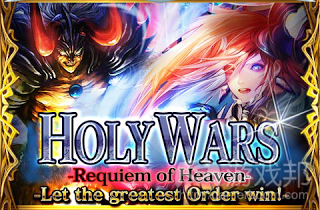
holy war(from gamasutra)
(《Rage of Bahamut》中的圣战是发生在短时间内的大规模公会战斗。当公会领袖宣战时,圣战就会被触发。对手公会是随机选择的,该公会的所有成员都会收到战斗通知。)
除了是定时事件,公会战争不同于排行榜的地方还有使用任命功能来吸引玩家加入公会。通过允许公会任命特定的成员作为会长、副会长、战将和守卫长等,使公会更加高效地运 作,因为少数被任命的玩家会促进整个公会的发展。
打副本
本质上,打副本类似于公会战争,因为也是让一队玩家在指定的时间段内对抗共同的对手。但打副本在两个方面不同于公会战争:第一,玩家在副本中对抗的是AI;第二,因为对 抗的是AI,所以往往有剧情元素,而在公会战争中是没有剧情元素的。另外,副本往往用特殊道具奖励表现突出的玩家。
Kixeye工作室非常擅长制作副本机制。他们的游戏根据玩家打副本的表现奖励玩家。通过打副本,玩家可以获得特殊的道具。是的,副本也是游戏和剧情的必要部分。
不要强迫
说到社交机制,我知道有许多人都不同意我的观点。对于那些人,社交游戏只与可测量的病毒传播力有关,社交功能可以直接与留存玩家和新玩家数量挂勾。发送X数的邀请换来Y 数的新玩家。
然而根据我的经验,这些无意义的社交机制并不能期生效。发送邀请带来的第一波新玩家峰值后,以后的每一次新安装都要求越来越多的邀请。这就使玩家对邀请和请求功能越来 越反感,最终导致用户体验恶化和留存率下降。
我的意思是,在设计社交功能时,你必须遵守一些非常简单的原则。首先要让玩家有时间按自己的方式玩游戏。让他们学习和享受游戏。然后把他们引入游戏的社交系统中。一旦 玩家喜欢上这款游戏,他们就会希望自己的朋友也来玩它,这时你可以加入社交机制,让玩家合作。合作应该有利于玩家双方,允许玩家炫耀。一旦玩家习惯合作后,你就可以加 入竞争元素。
说到底,还是留存率的问题。社交机制是提高长期留存率的好工具。
第四环节:营收设定
盈利法则
较高水平的盈利性,其通常法则也相对简单:DAU(日活跃用户)X 转化率(%)X ARPPU(每付费用户的平均收益)。即使该法则中有三个关系变量,我们通常也会因为鲸鱼玩家( 高消费用户)、售价点、DARPU、玩家数量以及开发者诱使玩家不断花钱的伎俩而更常关注后面两个变量。
我个人主张另一套方法。我真心认为要想实现可观的盈利目标,你就得忘掉那些盈利机制。而是关注留存率、游戏经济和社交机制。
我认为根据玩家在游戏中的投入时间减缓游戏进程,可以推动玩家转化率。社交机制在盈利中极为重要,因为它们会让玩家比较自己与他人的进程,并由此创造一种坚持下去的社 会责任。

Slush(from gamasutra)
(当玩家的进程逐渐减缓时,他们通常会更乐意花钱,也会在游戏中通过社交联系不断比较自己同他人的进程)
而在涉及盈利性时,我认为避免使用两种方法。一种是游戏内置道具的概念,也就是让玩家花真钱才能获得道具。第二种就是游戏内部促销的概念。
1.付费道具
添加游戏内置道具(仅限硬货币购买)是创造“花钱获胜”型游戏的最常用方法。添加超级强大的道具,并向有意花真钱购买的玩家供应道具,实际上是对非付费玩家,即最庞大 的玩家群体的一种歧视。
如果玩家没有其他方法赢取这些强大的付费道具,拥有这些道具者的胜利就会像是一种作弊行为。谁愿意同“作弊者”玩游戏呢?另外,如果玩家知道自己身边所有的人都花钱买 了道具,谁还会有获胜的信心?

respawnables(from gamasutra)
(Zynga的Respawnables鼓励玩家购买付费武器,这些高级武器可以消除所有游戏进程的障碍,并解琐新武器,所以会打破核心循环)
2.促销
游戏中持续运作的促销活动所存在的问题是,它们极大改变了玩家的付费习惯。当然,在促销期间你可以看到销量不断出现高峰,但促销活动结束后,相关数据就会开始急剧下滑 ,降至刚开始促销时的水平之下。换句话说,
这样只会培养玩家仅在促销期间花钱,并且避免在其他时间购买内容的消费习惯。
喜欢展开促销活动的产品经理,通常会强调他们在出售虚拟道具(游戏邦注:它实际上是一种无限资源)。但虚拟道具却有价值,即游戏进展。所以促销活动实际上是让投入的玩 家更快取得进展,并因此增加更多内容需求。
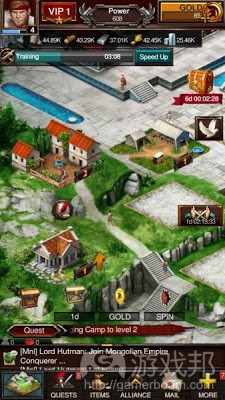
GoW(from gamasutra)
(Machine Zone所推出的《Game of Wars》以其频繁的促销活动而得名。他们开展了太多促销活动,以至于我都怀疑玩家到底会不会购买那些非促销道具)
不过也不要误解我的意思。我并不是完全反对促销。我认为要最好采用这两种促销方式。一种是针对非转化玩家的促销。鼓励这些玩家采取首次付费行动,在他们付费之后即停止 供应促销内容。第二种是季节性促销。例如万圣夜、黑色星期五、新年等假日促销。假期季促销不会影响玩家的消费习惯,因为假期准确地传递了促销活动的特殊性。
将盈利视为一种流
在我看来,可持续的盈利是出色的游戏设计、平衡的游戏经济、富有吸引力的社交机制以及一个新颖的方式所产生的结果。
我个人更情愿将盈利视为一种流。它始于玩家开始游戏之际,要为玩家创造一种这是一款很棒的新游戏,充满动作和娱乐趣味这种印象,让玩家觉得这是自己之前从未玩过的游戏 。
在给予玩家这种承认之后,就要令其重返游戏,确保玩家喜欢玩游戏。逐渐向其显示令游戏体验更完美的有趣功能,最重要的是,为玩家创造一种进步的需求。
当你的玩家想获得进步时,就要插入社交机制。确保玩家可以用一种互利互惠的方式合作。此外,还要确保玩家之间的合作发生于双方都能展示自己的环境中。
当你的玩家开始喜欢玩游戏,并且想获得进展,开始合作并炫耀自己的进步时,那就说明你获得了成功。
相关拓展阅读:篇目1,篇目2,篇目3,篇目4(本文由游戏邦编译,转载请注明来源,或咨询微信zhengjintiao)
Mid-Core Success Part 1: Core Loops
by Michail Katkoff
I’m going to be honest with you. I didn’t want to write about “mid-core.” I’m not a fan of portfolio thinking, and that is what mid-core essentially stands for: Casual games designed for adult males with gaming background but who simply don’t have time to play now that they are older. Games designed for adult males who have a steady income, a credit card and the desire to compete in a virtual world.
But what can I do? You demand a post on mid core and I deliver. So here it goes. Instead of one very long post, I’m going to break it down into 4 posts going through core loops, retention, social and finally monetization in separate posts.
This first write-up is about mid-core core loops, concentrating on not only the loop structure but also on what the loops aim to achieve. I’ll also talk about the cardinal sin of most mid-core titles and how to avoid it with proper core loop design. Finally, I’ll go into the invisible yet essential part of any mid-core game, the metagame.
Mid-Core Core Loops
When looking at core loops of successful mid-core titles, they all have three distinctive key elements. First is the dual loop, where each core loop consists of two separate session loops. A second element is the controlled length of a median session, which actually results from the dual loop. The third element is the metagame, which isn’t visible in the core loop, but is still a key part of any mid-core game’s success.
1. Dual Loop
Having a core loop consisting of two loops enables players to either stop their session after the first loop or continue playing through both of the loops and thus extend and deepen their session. Enabling and rewarding short sessions encourages players to play the game on the go, increasing overall engagement and setting players up for the metagame, which I will dive into later in this post.
Example 1: Clash of Clans
In all its simplicity, Clash of Clans’ core loop consists of three different actions: resource collection, building & training, and battling. All pieces of the loop, except building, encourage players to do multiple sessions per day. A very quick 30s session might be just about collecting resources, while a full session with attack and setting up new troops to be trained takes less than 5 minutes.
In CoC, resource collection is something players can do any time due to automated farming mechanics, where resource production buildings can always be collected. In other words, anytime the player opens up an app, there are resources to be collected (even if player has been raided). Quick visits to the game are thus encouraged via core loop positively, while long times away from the game are mildly punished with looting of unharvested resources.
Automated farming mechanic enables multiple ultra-short rewarding sessions a day.
Resource collection and threat to be looted are the main drivers for short sessions for low-level users, while high-level users are driven back to the game with social features, which I’ll cover in the metagame portion of this post.
Building new buildings is fast in the beginning but exponentially slows down as the game progresses, creating powerful mid- and long-term goals for players. To keep the timers in balance, the troop training is a lot faster, forcing player to wait often less than an hour till full army is again ready for battle.
Example 2: Marvel War of Heroes
Card battlers, and especially my favorite one, MWoH, are another example of successful mid core games with double loop. Where CoC’s core loop was tied to PvP, MWoH’s core loop is separated into single and multiplayer loops with distinctive energies for each of the loop.
Single-player loop is all about grinding and earning cards. Player can complete a level in well under a minute, earning several cards in the process. Same goes with PvP loop, which is even faster, as it’s only one battle. These two loops, fueled by energy mechanics, encourage players to come back to the game multiple times per day.
Longer sessions are created as a result of several smaller sessions. You see, when every session rewards player with multiple cards, at some point of the day player will end up spending considerable amount of time going through the gained cards entering the metagame of leveling up and evolutions.
2. Session Length
Overlong sessions length is the cardinal sin a mid-core game. As developers ,we just tend to get carried away with these games because they are the type of games we love to play. Don’t get me wrong, there’s nothing bad about a long session. In fact, long play sessions are great indicators of players enjoying the game. But if every session demands several minutes of uninterrupted attention it tends to result in retention problems. If players don’t play the game several times during short brakes around a day, the game won’t turn into a habit. And it’s when you go from a fun game to a habit that you start seeing those incredible six-month retention numbers.
Heroes of Orders & Chaos by Gameloft is a beautiful game but when every sessions demands 10minutes of uninterrupted gameplay, it’s just not something you can pick up and play.
3. The Metagame
In my mind, the most distinctive element of any mid-core game is the metagame. Metagame is the invisible part of the core loop that you have to experience. The part where players don’t actually earn or consume any resources but simply stay engaged in the game with a simple goal to optimize their progress.
Kixeye has one of the best metagame loops. Players are allowed and encouraged to micromanage their game in their pursuit for an edge in competition. And this whole micromanagement metagame is actually a lot of fun. It gives sense of control, which is very important in competitive games.
Short median session length is ideal to keep players engaged during the day. But in order to create that deep gameplay, which differentiates mid-core games, a game has to be able to keep players engaged fo long sessions as well. Enable sessions where players can go deep into the game strategy, break their goals into sub-goals and most importantly, interact with other players.
It’s All About the Balance
It should be no surprise that successful core loop in a mid-core title should follow pretty much the same lines as any f2p game’s core loop. Short, accessible and rewarding session should be the main goal. Instead of forcing players to do long sessions, players should be lured to spend more time inside the game through the metagame. Hiding the complexity and letting players to get curious themselves makes the game more accessible and is the key for successfully working metagame. Oh, and a gentle slap on player’s wrist for not logging in for a while is just fine.
And finally, don’t try to segment your audience. You’d be surprised who actually plays these games we like to call mid-core.
Retention is the foundation for a successful F2P game. Players who keep coming back to the game several times a day, day after day and month after month enable the game as a service model. But creating that drive for players to keep returning is without a doubt the toughest challenge for a game team. In this post I’ll break down how to overcome this challenge with a well thought out core loop, balanced game economy and clever use of events.
*Social mechanics are essential when building retention and progress, yet I’ll leave them mostly out of this post and instead concentrate on them in the following post.
The Main Goal
In my mind, there’s no better way to retain players than to have them set up goals for themselves. Self-motivated players will be logging in numerous times per day just to achieve that goal. But to create a user base of self-driven players, the game team has to first make players want to become better by rewarding them for progress and punishing for falling behind.
With the desire to improve comes the desire to progress. And desire to progress is extremely powerful, as players will self-create sub-goals for themselves and work to optimize their gameplay. My opinion is that the desire to become better should always be the main goal for every player. Because in a well- designed f2p game, improving equals progressing and progressing should equal the amount of time spent playing the game.
Personally, I like to divide progression incentives into positive and negative, where positive incentives promise players that they’ll be stronger, tougher and better once the goal is achieved. Negative incentives on the other hand threaten players that they’ll fall behind if they stop progressing towards the main goal.
Positive Incentive to Progress
In-game shop is one of the best ways to encourage progression. Price and unlock requirements needed to gain access for specific units create a very clear target for players. Also, the position of a specific unit in the in-game shop is important, as it communicates value – the last ones to unlock are the strongest and the most desired.
Unlocking new units in Clash of Clans is a clear goal for players. New units also promisebetter results in battle creating that positive incentive to progress.
Negative Incentive to Progress
Players’ progression slows down exponentially with time. Timers will increase and prices will rise, making it harder and harder to progress. At some point the next unit or a building just might seem bit too far away. This is when negative incentives should kick in, showing players that slowing down just isn’t an option.
Getting raided is a negative incentive. Players realize that current defenses aren’t enough and that they need to progress to defend themselves. Negative incentive at its best.
Most importantly, when designing progress incentives, one should always keep in mind that the social element is an important driver for progress. Progress is hard to objectively measure, which is why game design should encourage players to compare their progress with other players be it through collaboration or competition. I’ll cover social elements in the third part of mid-core post series.
Sub-goals
Sub-goals are all the steps players acknowledge they need to take in order to reach their main goal. Personally I like setting up sub-goals with interdependable game economy. Clash of Clans, among other strategy games, is a great example of this kind of economy structure as it presents a clear goal for the player hiding the long path it actually takes to get to that goal. This way, the road to that ultimate goal might seem short and very achievable to players. Only once they are mid-way through the grind will they start realizing how long it actually takes to reach the target, but at that point they’ve Unlocking the next unit might seem like a pretty easy task – all a player needs to do is upgrade the Barracks. But before that they need to upgrade the Town Hall. Oh and Town Hall upgrade is so expensive that they have to upgrade Gold Storage. Pretty straightforward. Right? It only takes 21 days to get there with an optimal gameplay. Add few raids and the 21 days get doubled…
There are two schools when it comes to sub-goals: Some designers like to communicate sub-goals to players and almost force them to follow a set path of progress. Another way to handle sub-goals is to give players the freedom to progress as they will, even though this often leads to not so optimal progress. Also, free progress makes tracking of an average player’s progress more complicated, which leads to challenges in content updates.
Kabam likes to manage players towards the main goal with strict mission structure.
This allows control over player flow and thus helps to optimize it.
Supercell uses an achievement system, which incentivizes players’ repeat actions in the core loop.
This system doesn’t help to optimize the player flow but it does give players freedom to make up their own sub-goals instead of just doing what the game tells them to do.
Events
Regular in-game events are a powerful tool for driving short-term engagement and long-term retention. Because of their timed nature, events encourage players to heavily engage with a game for a relatively short period of time.
Typically, events last from a few hours to several days, but sometimes events might last for weeks. Usually events are designed for players who have already been playing the game for a while. Overall, events are an excellent way to spice up the gameplay for these retained players resulting in increased long-term retention.
There are few key elements all successful events tend to have. The first one is naturally the limited time the event is active. Second is the event-specific inconsumable reward, which players receive if they are able to complete the event in a given time. Uniqueness of the reward is important for engagement, while the inconsumable nature of the reward turns it into a status symbol.
Also, giving the reward for completing an event after the actual event has ended is a way to boost retention. Some players do get tired of the game during an ongoing event, as it requires so much playtime. But, giving that usable reward after the event has ended will keep players playing the game, as it will have something new for them. Finally, it is important that events follow a game’s core loop instead of adding new elements to it.
Example: Marvel War of Heroes
From time to time the player receives a Treasure (collectable item) when grinding through the PvE quests. Each collectable item is a part of a six piece collection. Once a player possesses all six items in the collection she’ll receive a unique card and the collection will be completed. Completed collection transfers into collection reward while also closing the collection from looting.
Players can loot the lacking treasures from other players while buying timed shields to protect looted ones.
Of course, having one rare card is never enough in Ngomoco’s card games as you need at least two of the same to fuse into one super-powerful card. So the player is encouraged to finish the collection three times: first collection reward is the card XY, second reward is Bonus and third reward is again the card XY).
What makes grinding collections interesting in Mobage’s card games is the fact that you can steal specific Treasures from other players – and other players will try to steal the Treasures you posses. Stealing ends only when collection has been completed.
The way looting monetizes is amazing:
A player has to be fast when he sets to complete a collection, as somebody is always looking for the Treasures he has at the moment. Being fast means usually buying PvP energy as there’s no time to wait for energy to reload.To loot a Treasure a player needs to have strong attack deck. Buying an additional card pack seems like a good investment when you get beaten one too many times.
To successfully defend the collection while looking for missing pieces, a player needs to have a strong defensive deck. Buying a card pack sounds like a great idea when your defenses have been defeated over and over again.
Players can also put a timed defensive shield over the collection items they just looted. When a player tries to loot an item protected by a shield, they automatically lose. There’s a custom animation to this kind of battle and it sucks to be on the receiving end. It actually sucks so much that you want to put shields on all of your Treasures just to make all those players who try to steal from you regret it.
Make Every Session Count
Retention is simply a games most important metric. Successful mid-core titles hold on to players for months, having them play over half a dozen daily sessions and spending well over an hour interacting with the app daily.
To reach these retention numbers, developers need to make sure players want to progress, then create paths to these goals with an interdependable game economy. I wouldn’t spend too much time on so-called retention features like daily bonus and push notifications, as they bring nothing more than cosmetic improvements. Instead I’d concentrate on the game economy and balancing. Make players want to be better and set up goals into the horizon. Then, either guide players to these goals via mission structure, or let them create their own sub-goals. Just make sure that every session takes them at least a bit closer to that goal they’ve set up.
Having started my gaming career back when Facebook was the ruling gaming platform for casual games, for a long time I saw social mechanics simply as viral mechanics – levers, which game teams could use to drive up the returning and new users to the game. But (luckily) both my perspective and the ruling platform have changed.
Forcing players to connect via Facebook and making them send dozens of invites and requests a day may still work for a few developers, but you’d be amazed how poorly these mechanics fit and work in mid-core titles. So instead of K-factors and virality, I want to write about true social mechanics. The kind of social mechanics that add to the gameplay, improve overall player experience and make the game feel more alive.
Collaboration
What makes a game social is that it allows players to play with each other – or at least create an illusion that this is happening. In my mind, social mechanics should be implemented first and foremost to improve retention. As I discussed in the previous post, retention is mainly about progress. But progress is a player-specific metric. For example, I might see myself as well-progressed in a game after few weeks, but to players who have been playing the game for months, I’m still a noob.
To solve the issue of progress measurability we can use social mechanics. When players collaborate with each other in a game they are bound to compare each other’s progress. Comparing progress leads to two kinds of feelings. Firstly, those players who are clearly lagging behind will want to progress and catch those ahead of them. On the other hand, progressed players will feel good about themselves and won’t want to lose the feeling of being ahead and above.
The key thing to remember when designing collaboration mechanics is that collaboration between players should take place in an area of the game, where players can easily show off. Also to keep in mind is that collaboration must benefit both of the players.
Puzzle & Dragons
Every time players enter a dungeon they have to choose a player to help them. When the players have cleared a dungeon they can become friends. Having friends helping you out gives you more Pal Points, which are then used to get monsters from the Machine.
Puzzle and Dragons relies mostly on one social feature: Helper. There’s no chat in P&D. No player versus player mode. No direct messaging with other people. No guilds. And no social network integrations. Yet every time player enters a dungeon they have another player as their helper – and the amount of friend requests players send to each other is huge, due to this simple mechanic.
The Helper feature in Puzzle & Dragons follows the golden rule of social mechanics.
It allows players to collaborate so that both parties benefit and occurs in an area of the game where players can show off.
Before entering a dungeon, the player has to always choose a helper, which is a monster from another player. Every time players use another player’s monster as a helper, helper’s owner receives Pal Points, which are a sort of currency consumed to operate the Machine and get new monsters. The more often a player logs into the game, the higher the chance there is to appear as a helper for other players and thus earn more Pal Points.
After a player has cleared a dungeon, they can add helper’s owner as a friend by sending a friend request. Players can have a specific amount of friends based on their rank. The higher the rank the more friends players can have. Using friends’ monsters as Helpers results in getting more Pal Points, as well as getting additional Leader Skill, which makes your monsters more powerful. Having active friends is thus crucial, as players can use helper only once, after which they have to wait until helper’s user logs out and logs back into the game.
So in short, the social mechanics in P&D drive retention by encouraging several logins per day. Social mechanics also drive players to progress, as the better helper monster they have to offer the mre often it will be used, which will result in player getting more Pal Points, which are then used to get new monsters from the Machine.
Most importantly though, the design of this feature takes place in an area of the game where players can show off. I mean, it’s all about how tough of a monster you have, and giving another player a chance to play with your monster is the ultimate show off. Also, both players benefit from these social mechanics. A player who borrows a monster gets Pal Points and a player who uses other player’s monster gets much needed help to complete levels.
Clash of Clans
Now we all know how Troop donation mechanic in Clash of Clans works. Once a player joins a clan they can request and donate troops. Donated troops will either help to defend a player’s village, or they can be used in attack. Despite the simplicity of the donation, it is one of the most powerful social features I’ve experienced.
Donation feature in Clash of Clans is one of the most powerful social mechanics I’ve seen.
From the game side, there’s no set number of troops a player should donate weekly. Neither is there a bonus for donating more, nor punishment for failing to donate. Yet nothing is followed by players as much as donations. Simply by enabling players to collaborate and communicate, the game allows players to create rules themselves – and with the ability to kick players off the clan, these rules are also enforced.
So in practice, once a player joins an active clan, they have to donate constantly. Active clans tend to set a number of donations each clan member has to make in a week. If a player falls behind without a good reason, they get kicked out of the clan. Donation drives retention, as players not only have to constantly be training troops for donation, but they also have to progress in the game because clans naturally demand the best type of units for donation.
By adding tracking to donation collaboration starts transforming into competition.
Because donation follows the game’s core loop and requires progression, it is a very powerful monetization feature as well. With every monthly update there are new troops and troop levels. Because clans demand the best possible troops for donation, players tend to buy the missing resources (and speed up research times) to finish the troop upgrades. Being the first one in the clan who donates a new unit raises that player to a social pedestal and drives everyone else to hurry up their upgrades.
As with P&D, Clash of Clans also follows the golden rule of collaboration mechanics. Donating troops to other players is – in a way – a show-off, as players can boast on the level of their troops as well as on how generous they are. And, in the end, both partiers benefit from donations. Those who receive them get help in battle, and those who donate improve their status inside the clan.
Competition
Creating competition between players is another excellent way to have players compare their progress. The problem with competition designs in games is that most of the developers want to get players into the competition phase too early. The best way, in my opinion, is to have players first enjoying the game, then enable social mechanics by acquiring in-game friends, have them collaborate with these friends and only after that incentivize them to compete.
Generally speaking, there are two types of competitions: the ones where players compete against each other individually and the ones where players form groups to compete with other groups of players. Most importantly, when designing competition features, social mechanics should be an important part of the conversation, as they intensify these features tremendously.
Leaderboards
If you want to target your top players, the leaderboard is one of the best features for that. Simply putting players into order based on how they have progressed or how they fare against other players will affect only a very small percentage of your players. Yet those who it affects tend to be the most engaged ones and will appreciate this opportunity to show off.
Group leaderboards, such as the Clan Leaderboard in Clash of Clans, are an excellent and very easy way to broaden the effect of simple player based leaderboards.
The next step is group leaderboards, such as the Clan Leaderboard in Clash of Clans. Not only does this feature affect a larger percentage of players, but putting players into teams and grading them as one will force every player in the team to do their best. By enabling direct communication such as group chat and direct messages, you basically enable peer pressure, where clan members will force lagging players to up their game while publically praising the top performers.
Guild Wars
In all its simplicity, guild wars are timed events between two groups of players triggered directly by players themselves. As with leaderboards, what makes guild wars powerful is the social aspect. Again, peer pressure plays an important role, as communication inside the guild is all about who’s active and who isn’t doing her/his part in the war.
Holy Wars in Rage of Bahamut is a large scale Order battle where within a very short time frame, order members will engage in battle against each other. Holy War will trigger when leader of an order declares a war. Opposing Order is chosen randomly and battle notification will be sent to all members in the Order.
Apart from being a timed event, guild wars also differ from leaderboards by using nomination techniques to super-engage a few players in the battling guild. By enabling guilds to nominate specific players as leaders, vice leaders, attack and defense leaders and others, you will enable the guild to run more efficiently during the event, as these few nominated players will drive the whole guild to over-engage.
Raids
Essentially, raids are like guild wars, as they unify a group of players against a common opponent for a specific set of time. Yet raids differ from guild wars in two ways: Firstly, raids are against AI. Secondly, because raids are against AI, there tends to be a story element in raids, which is lacking in guild wars. Also, raids tend to award participating players with unique items based on how active they’ve been.
Kixeye has pretty much mastered raid mechanics. All of their live games run periodic raid events in which players are rewarded for the level of engagement they show during the raid. By participating in the raids, players gain access to special units and parts. And yes, raids are promoted heavily, like the video above shows, which make them an essential part of the game and storyline.
Just Don’t Force It
I know a lot of people are against my opinions when it comes to social mechanics. For them social games are all about measurable virality, where social features can be directly tied to the amount of returning players and new installs. For them, X amount of invites sent is Y amount of new installs.
Yet from my experience these unmeaningful social mechanics just don’t work on a long-term basis. After the first couple of spikes in metrics, you’ll need to generate more and more invites for one single installation. This leads to an increasing amount of slapped-on requesting and inviting features that degenerate user experience and hinder retention.
What I’m saying is that you should follow a very simple approach when it comes to social features. First start off by giving your players time to play the game by themselves. Let them learn and enjoy it and have fun, then allow them to turn social. Once they like the game and want their friends to play it as well, you can introduce social mechanics, that let players collaborate. Collaboration should benefit both of the players and occur in a game area where players can show off. Once players are collaborating you can start adding competitive element.
In the end it’s pretty much all about retention and social mechanics are an amazing way to improve especially long term retention.
The following blog post, unless otherwise noted, was written by a member of Gamasutra’s community.
The thoughts and opinions expressed are those of the writer and not Gamasutra or its parent company.
I left monetization as the last piece in the mid-core success series simply because I see monetization as a result of a well-functioning core loop, strong retention and meaningful social mechanics.
Thus you won’t find best tricks and tips on how to get people to spend in this final post of the mid-core series. Instead, I’ll present monetization as a flow of all 3 of the success parts introduced in previous posts.
Formula for Monetization
On a high level, the formula for monetization is actually pretty simple: DAU (Daily Active Users) x Conversion (% of payers) x ARPPU (Avg. Revenue Per Paying User). Even though there are three key variables in the formula, we tend to focus on only the two latter ones with the discussion revolving around whales, price points, DARPU, amount of payers and all those little ‘tricks’ developers employ to incentivize players to pay and pay more.
Personally, I have a different approach. I honestly believe that in order to achieve that desired financial result you have to simply forget all those monetization features. Instead of monetization you should concentrate on retention, game economy and social mechanics.
I believe that demand for players to convert is created by slowing down the rate of progress in line with time spent playing a game. Social mechanics are vital in monetization because they make players compare their progress to others’ and thus tend to create a social obligation to keep up.
Players are primed to spend when their progression slows down over time and they are constantly comparing their progress through social interaction inside the game.
The Monetization Don’ts
There are two commonly used approaches I suggest avoiding when it comes to monetization. First is the concept of in-game items, which players can only get by spending real money. Second is the concept of in-game sales.
1. Premium Items
Adding in-game items, which are sold only for hard currency, is the most-used way to create a pay-to-win game. By adding these super powerful items and offering them only to players who are willing to spend real money on the game, you’re essentially discriminating against the non-paying players, aka. the majority of a player base.
If there’s absolutely no way to earn these powerful premium items, the players who have them will be seen more or less as cheaters when they rack up wins. And who wants to play against ‘cheaters’? Also, who wants to win when everyone around him knows he paid to get the W?
Zynga’s Respawnables encourages player to purchase premium weapons, which players can get only with hard currency. These premium weapons eliminate all the need to progress and unlock new weapons thus killing the core loop.
2. Sales
The problem with constantly running in-game sales is that they significantly change players’ purchasing habits. Sure, you’ll get those nice sales spikes when the sale is running, but once the sale is over, your numbers will drop way below the levels where they started. In other words, you’ll teach your players to purchase only during sales and avoid making purchases at other times.
Product Managers, who like to run sales, tend to underline that they are selling virtual items (at least that’s what I used to say a few years back), which is essentially an infinite resource. But virtual items have value and that value is progress. So running sales actually allows engaged players to progress faster and thus increases the demand for more content.
Game of Wars by Machine Zone is notorious with their pushy sales. They run so many sales that I’m actually unsure if you can purchase something that’s not on sale.
Don’t get me wrong though. I’m not totally against sales. Personally, I like to do two kinds of sales. First are sales aimed at players who haven’t yet converted. Encouraging these players to make their first purchase, then stopping offering sales to them after the purchase is made is a sound approach. The second is seasonal sales. Halloween, Black Friday, New Year etc. Seasonal sales won’t affect a player’s purchasing habits, as the season communicates clearly the uniqueness of a sale.
Treat Monetization as a Flow
In my mind, sustained monetization is a result achieved through excellent game design, balanced game economy, engaging social mechanics and a fresh approach.
Personally, I like to look at monetization as flow. It all starts when player begins the game, by creating the impression that this is a cool new game, full of action and entertainment. It’s a game players haven’t played before.
After wowing the player and getting her to come back, it’s time to get to work. Make sure player enjoys playing the game. Gradually show all those interesting features that make the game experience so much better, and most importantly, create demand for the player to progress.
When your players want to progress, it’s time to get those social mechanics in. Make sure that players can collaborate in a way that benefits both players. Also, make sure that the collaboration between players happens in an environment where both of them can show off.
When your players are wowed from the get-go… When your players are enjoying your game and want to progress… When your players collaborate and show off their progress… Then you have a mid-core success.







































 闽公网安备35020302001549号
闽公网安备35020302001549号